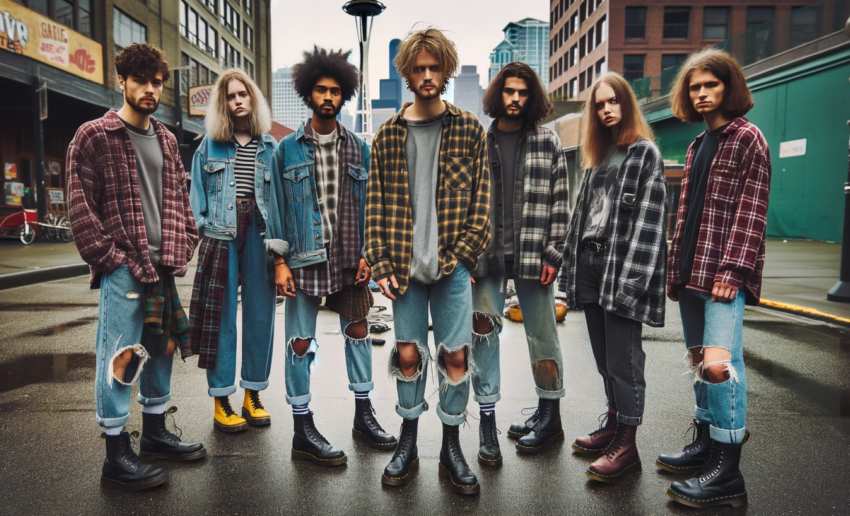Grunge Era's Unruly Threads: 1990s Seattle

The Birth of Grunge
Picture this: It was a dark, rainy day in 1990s Seattle, and the city was about to witness a fashion revolution, a rebellion against the mainstream, an explosion of flannel and torn jeans. The grunge movement had infiltrated the music scene, and with it came a new era of style that would shape the decade. Yes, my friends, we're talking about the fashion phenomenon of Seattle's grunge era.But what was it that made the 1990s in Seattle a breeding ground for this fashion uprising? Was it the dreary weather, the thriving alternative rock scene, or the city's fascination with thrift store shopping? Whatever the reason, it was undeniable that Seattle was the epicenter of a movement that would shake the fashion world to its core.
Flannel Mania
What is grunge fashion without flannel? The humble flannel shirt, a staple of lumberjacks and winter wardrobes, took on a whole new meaning in 1990s Seattle. It was everywhere. On the streets, in the clubs, and, of course, on the stage. The biggest names in grunge - Nirvana, Pearl Jam, Soundgarden - all donned the flannel with pride. And why not? It was comfortable, affordable, and perfect for those chilly, damp Seattle days. Plus, the flannel's versatile nature made it easy to wear tied around the waist during a particularly sweaty mosh pit session.Denim Delirium
Let's not forget the bottom half of the grunge equation: the jeans. Much like flannel shirts, jeans were a staple in every grunge enthusiast's wardrobe. But these weren't your average jeans - no, no. The grunge era demanded something more rebellious, more anti-establishment. And so, the distressed and torn jean was born. These weren't the neatly ripped jeans of today's fashion-savvy youths. No, grunge denim was a haphazard collection of frays, holes, and tears that screamed, "I don't care about your fashion norms!"And if you thought the grunge movement was all about pants, think again. Denim jackets and vests were just as prevalent, often adorned with band patches or political statements. Because what is grunge fashion without a little activism, right?
Boots, Boots, and More Boots
It's hard to imagine a grunge outfit without the iconic footwear of the era: the combat boot. Sure, sneakers had their place in the grunge scene, but there was something about the rugged, industrial look of a pair of combat boots that just felt right. Practical, durable, and always ready to kick some ass, these boots were the perfect accompaniment to the flannel and denim ensembles of the time.Accessorize, Accessorize, Accessorize
Now, you may think that grunge fashion was a minimalist affair. And for the most part, you'd be right. But that doesn't mean that there wasn't room for a few well-placed accessories. It was all about the details, you see. Bandanas, beanies, and oversized knit caps were essential headwear for those who wanted to keep their unruly locks in check. And let's not forget the plethora of chokers, dog tags, and other neck adornments that were all the rage among the grunge crowd.But perhaps the most iconic accessory of the grunge era had to be the thrift store find. From vintage flannels to unique jewelry pieces, the thrift store was a haven for those seeking to inject some individuality into their wardrobes. It was a treasure trove of one-of-a-kind items that allowed the grunge dresser to truly express themselves and their disdain for mainstream fashion.
A Fashion Legacy
As the 90s drew to a close, so did the heyday of grunge fashion. But the legacy of this rebellious style movement lives on. Its influence can still be seen in today's fashion trends, with distressed denim, flannels, and combat boots remaining popular wardrobe staples.The grunge era's unruly threads may have been born out of a desire to rebel against the mainstream, but in doing so, they created a lasting fashion statement that remains relevant to this day. So the next time you throw on your favorite flannel or rock a pair of well-worn jeans, take a moment to remember the origins of your outfit and the city that started it all - 1990s Seattle.
Article kindly provided by foreverinfashion.org
Latest Articles
- The Psychology of Tattoo Aesthetics: Why Certain Imagery Resonates
- Style That Works With Your Body, Not Against It
- Fashion Tourism on Wheels: Curated Shopping Routes Led by Chauffeur Guides
- The Charm of Certainty in a World of Indecision
- Can an Everyday T-Shirt Be Turned into a Modern Heirloom?
- Color, Ceremony, and the Psychology of Celebration
- Styling Graphic T-Shirts for Different Body Types
- Getting Kids to Wear Their Hats Without a Bribe or a Meltdown
- Mastering the Art of Being the Unnoticed Photographer
- Quiet Sportswear Moves Loudly
- Fashion's Most Misunderstood Color Is Brown
- Weight Matters When Cotton Gets Real
- SKU's Out for Summer: Why Your Warehouse Is Melting Down
- Ink as Accessory - How Tattoos Are Replacing Jewelry in Modern Style
- Accessories
- Jewellery
- Footwear
- Skirts and Dresses
- Shirts and Blouses
- Beauty and Makeup
- Fashion Photography
- Sustainable Fashion
- Street Style
- Fashion History
- Fashion Business
- Fashion Styling
- Fashion Events
- Plus-Size Fashion
- Men's Fashion
- Women's Fashion
- Fashion Blogging
- Fashion Trends
- Fashion Retailers
- Fashion Tips and Advice
- Fashion Business Startups
- Fashion Around the World
- Lingerie
- Sportswear
- Weddings

